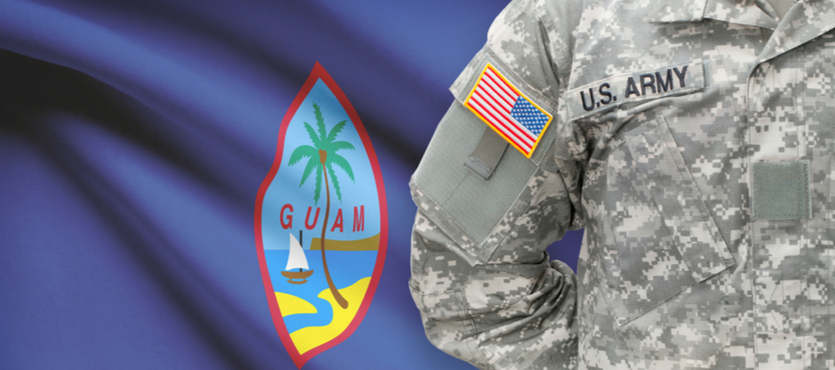As construction continues on the entire island, Gov. Lou Leon Guerrero, Joint Region Commander Rear Adm. John Menoni, and Guam State Historic Preservation officer Carlotta Leon Guerrero recently signed a pact which outlines historic and cultural preservation priorities.
The pact mostly focuses on military training. A special commission will monitor these exercises and produce archeological reports before and after each exercise. A similar agreement had been signed in 2009, but many observers believe it was incomplete and outdated.
Treaty negotiations began in earnest in late 2020, following an October discovery of a naitive Chamorro burial ground near Camp Blaz, an under-construction Marine base. Scientists believe the remains of four people were more than 1,000 years old.
Guam’s Military Significance
China is less than a six-hour flight from Guam. As tensions continue simmering in the South China Sea and elsewhere, a conflict between the United States and China seems increasingly likely. If that happens, Guam could be an important forward operating base for both aerial and naval forces.
Military planners are already making Guam an important piece of the puzzle. But before that fully happens, Guam’s military facilities, most of which date back to the Vietnam era, must be improved. Hangars must be bigger and runways longer to accommodate modern aircraft. Harbor facilities must be upgraded as well. The same thing goes for barracks and other such facilities, many of which are pre-Vietnam.
As outlined below, contractors play a pivotal role in this process. Contractor support is also critical if and when the shooting starts.
Ever since the Spanish arrived in the 1560s, it has been an important military installation for the various foreign powers that have occupied it. For over 300 years, Guam was an important stopover in the grueling Manila to Acapulco galleon run. In the early 1900s, the first U.S. overseas military installations appeared in the recently-acquired territory. The Navy built a shipyard here in 1901. In 1921, a contingent of U.S. Marines was the first Pacific deployment for this military branch. The Marines would go on to bigger things during World War II.
Guam would have played a significant role in American military operations during that war. But the Japanese occupied it the day after Pearl Harbor was bombed. The Japanese spent most of their energy exploiting the indigenous population.
Apropos of nothing, one of the last World War II Japanese holdouts surrendered on Guam in 1972. “I am ashamed that I have returned alive,” Shoichi Yokoi announced when he returned to Japan. Yokio and about 1,000 other soldiers apparently hid in the forests shortly after Americans retook the island in 1944. Yokio, who ran for Parliament and lost, died in 1997 at age 82.
During the Vietnam War, Guam was an important airbase for Operation Linebacker and other North Vietnam bombing campaigns. In 2018, a U.S. government report alleged that the military used Agent Orange as a defoliant around the sprawling Andersen Air Force Base. The DoD disputed these findings.
Contractors in Guam
Andersen AFB is one of the largest military facilities in the world. But it would not be large enough to accommodate all the assets which would be in Guam if war breaks out. The same goes for the naval and other facilities on the island.
Construction contractors will probably handle much of this expansion work. Typically, most project planning takes place stateside. Locals do most of the work, largely to tie the community to the project and contribute some money to the local economy. Overseas contractors usually serve as managers and supervisors. These people make sure the work gets done on time and under budget.
Security contractors will be needed on Guam as well, albeit in much smaller numbers. Some Guamanians are not happy about the American occupation, especially in light of the aforementioned Agent Orange controversy. The preservation agreement might soothe some feelings in this area, but not all of them.
As operations expand, there is also a significant need for longshoremen. Almost everything and everybody on Guam arrives and leaves by ship. So, there is a tremendous amount of cargo to be loaded and unloaded every day. And, as the military presence expands, space will be at a premium.
Injury Compensation Available
All these contractors are vulnerable to both trauma injuries, like falls, and occupational diseases, like repetitive stress disorder. The Defense Base Act provides benefits which take care of the substantial medical bills these victims incur.
Emergency care and follow-up care are normally the biggest chunk of these bills. Inpatient treatment usually costs about $3,000 a day. These costs quickly add up to astronomical amounts. That’s especially true when ancillary costs, like medevac costs, are added. A medical flight from one end of town to another might cost $40,000. Imagine what a medical flight from Guam to Hawaii, California, or Tokyo would cost.
Most victims also need substantial physical and/or occupational therapy. Physical therapy helps victims regain lost function after they are injured. Occupational therapy helps victims acquire new skills, so they are not totally disabled.
Generally, victims benefit greatly from extended therapy. Unfortunately, many DBA insurance companies try to cut off funding after a few months or even a few weeks. Your DBA attorney advocates for you in these situations, so the money keeps flowing and you keep improving.
For more information about DBA wage procedure, contact Barnett, Lerner, Karsen, Frankel & Castro, P.A.

